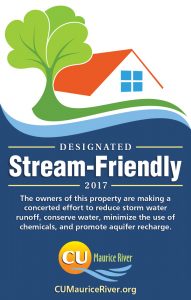The Maurice River Watershed has remarkable water quality, abundant open space, and plentiful biodiversity: no small feat for a region in America’s most densely populated state. However, poor land-use practices can compromise the health of the watershed.
When the workings of a watershed are impaired, it causes serious problems:
- flooding
- water shortages
- surface run-off
- soil erosion
- change in water flow
- water contamination
- invasion by exotic plants
- loss of habitat
- property damage from storm surges
The condition of streams and rivers is a reflection of the diverse land uses within the watershed. Land management decisions made on residential properties ultimately impact the health of the entire river basin and community. Poor land use leads to dirtier water, less water, and damaged habitats, while good land use has positive impacts on:
- water quality
- water regeneration
- healthy habitat
 This Stream-Friendly Designation Application provides active Maurice River Watershed stewards a way to have their best management practices recognized. Maybe you are already implementing eco-friendly management practices on your property and are looking to expand upon them, or maybe you are just getting started and need some ideas. Regardless of your current stewardship level, continue reading to learn how your property can earn Stream-Friendly designation.
This Stream-Friendly Designation Application provides active Maurice River Watershed stewards a way to have their best management practices recognized. Maybe you are already implementing eco-friendly management practices on your property and are looking to expand upon them, or maybe you are just getting started and need some ideas. Regardless of your current stewardship level, continue reading to learn how your property can earn Stream-Friendly designation.
Respond "yes" or "no" to whether you have included the actions from the following list into your management routine.
- Each yes answer is the equivalent of one stewardship point, while no responses represent opportunities to expand on your best management practices.
Applicant Name(s)
Property Address
City
E-mail
Phone